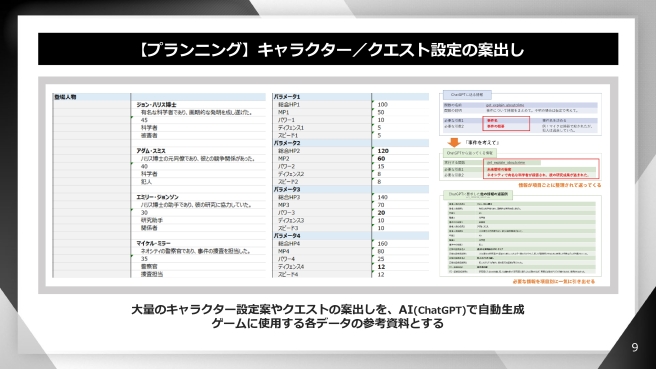Level-5 embraces the use of AI technologies in their development pipeline.
As Artificial Intelligence technologies, such as automated text, image or sound generation, continue to evolve, many ethical and legal questions arise surrounding their use. It is in that context that the Japanese government has been holding a “Study Committee on Intellectual Property Rights in the Age of AI” (AI時代の知的財産権検討会).
As reported on by ITmedia NEWS, the committee’s 4th meeting took place on December 11th, and Level-5’s CEO Akihiro Hino was among the list of speakers, with a presentation of a few examples of how the company integrates AI in the development of their various projects. You can find the complete PDF of the presentation on the committee’s website.
Title screen layout and concepts
Taking Megaton Musashi: Wired as an example, Hino explains that they first used StableDiffusion to generate illustration concepts. One of them was then chosen and used as a reference to create an original illustration, which was then animated and used as the game’s title screen. In this scenario, the title screen illustration is entirely original, with the AI-generated image only serving to give an idea for the illustration’s layout.

3D illustration concepts
Taking this time Yo-kai Watch protagonist Keita Amano (Nate Adams) as an example, Level-5 trains StableDiffusion on their own character design sheets, and provide the tool a base and instructions to generate 3D-style images, with various texture, lighting and atmosphere effects to experiment with and to serve as reference.

3D map concepts
AI is also used to generate 3D map references. Hino shows an example of a very simple 3D model of a room, with just the basic geometry and no textures. StableDiffusion is then used to generate illustrations of rooms, and these illustrations are then “projected” onto the room’s 3D model, in order to obtain a 3D map which can then be used as reference.

Background environment and illustration concepts
Level-5 also uses StableDiffusion to generate illustrations of environments, such as this futuristic city (which may be from Decapolice, as we’ll see in the next section). Generated images are then edited and modified to integrate various elements matching the game’s universe and worldview.

AI can also be used to generate background elements such as buildings and crowds. One such example is Inazuma Eleven: Victory Road, which incorporated crowds from AI-generated images of stadiums in the background of key artwork from its 3rd trailer: while the characters in the foreground are definitely original illustrations, the audience in the background is entirely taken from AI-generated images.

Character and quest concepts
This one is what will interest us the most, as even though Hino did not name the game, it is very clearly taken from Decapolice.
Level-5 uses ChatGPT to generate a large quantity of character concepts and quest contents, which are then used as reference during development. Using a “get_explain_aboutcrime” function, taking a quest name and summary as arguments, ChatGPT “imagines” the rest, and provides a complete overview of a case for the player to investigate, such as the key characters, how the crime took place and who the culprit is, what pieces of evidence can be found…

The example given is a quest called “The Secret of the Futuristic City”, with the following summary: “A famous scientist was murdered in Neo City, and the results of his research have been stolen”. From there, ChatGPT gives a list of characters with names, ages, a brief summary of who they are, and what role they play in the story: the “famous scientist” from the initial pitch becomes Professor John Harris, a 45-year-old scientist who made a “groundbreaking invention”; meanwhile, the culprit (spoilers?) is his former colleague and rival Adam Smith, who commited the murder using poisonous gas in order to steal the prototype of a brand-new energy source.
All the data is provided in a convenient Excel spreadsheet format, which can be used by the development team as a reference to create the quest. Other generated data includes character stats, such as their HP, strength, defense…
Temporary voice generation
During development, Level-5 uses a combination of homemade tools and a voice synthesiser called VOICEVOX to generate temporary voice clips (mainly for short interjections such as “Hah!”, “Take this!”, “Great!”, to be used in battles for example). This allows them to quickly generate audio clips in large quantity and integrate them into the game during development, as placeholders until the actual voice lines are recorded by the voice actors.

Using AI for promotional materials
Level-5 also uses AI outside of game development, for tasks such as website development or creating promotional illustrations.
Their websites are programmed with the help of Genie AI (ChatGPT) and GitHub Copilot, which generate code automatically, or analyse the existing code to help identify possible optimisations.

For promotional illustrations, just like other illustrations, StableDiffusion can be used to come up with composition ideas. This was the case for Inazuma Eleven’s 15th anniversary illustration, whose circle-shaped composition was inspired from an AI-generated image.

SwinIR is also used to upscale illustrations, for example to be able to display key artwork of their games on the walls of their Tokyo Game Show booth.




Finally, even their Tokyo Game Show stage itself was conceived with the help of AI! StableDiffusion was used to generate design ideas of stages using 4 LED screens, and those served as a base to design the actual stage that was seen at the event.

In conclusion, Level-5 uses AI mainly as part of the ideation process, to generate base data around which they can develop game content, and generally speaking ease and improve their development workflow. This presentation gives a good idea of what part AI plays in the creative process, and how Level-5 attempts to make these technologies coexist with traditional artistic and technical skills (illustrating, voice acting, programming…).

